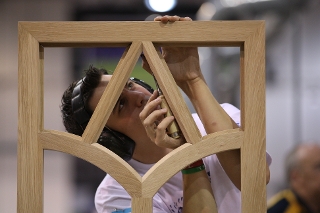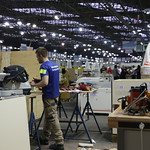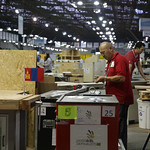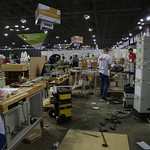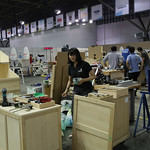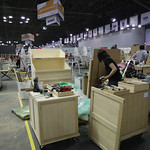Joinery
Skill Explained
A joiner generally works on commercial and residential projects. There is a direct relationship between the nature and quality of the product required and the payment made by the customer. Therefore the joiner has a continuing responsibility to work professionally in order to meet the requirements of the customer and thus maintain and grow the business. Joinery is closely associated with cabinet making and carpentry plus other parts of the construction industry and with the many products that support it, normally for commercial purposes.
The joiner is usually based in a workshop because the formation of various joints requires specialist machinery, but sometimes undertakes installations in the homes of customers and on building sites. He or she will produce and interpret drawings, set out and measure, cut, form joints, assemble, install and finish to a high standard. The joiner usually produces items such as interior and exterior doors, windows, stairs, tables and bookshelves.
Work organization and self-management, communication and interpersonal skills, problem solving, innovation and creativity, working precisely and accurately are the universal attributes of the outstanding joiner. Whether the joiner is working alone or in a team the individual takes on a high level of personal responsibility and autonomy. From working safely through to exceptional planning and organizing, accuracy, concentration and attention to detail to achieve an excellent finish, every step in the process matters. Mistakes are largely irreversible and very costly.
With the international mobility of people, the joiner faces rapidly expanding opportunities and challenges. For the talented joiner there are many commercial and international opportunities; however these carry with them the need to understand and work with diverse cultures and trends. The diversity of skills associated with joinery is therefore likely to expand.
What the Competitors do at the Competition
Competitors will be judged on:
- Knowledge and understanding of drawings
- Interior and exterior joints
- Finish and appearance
- Conformity to ISO standards
- Measurements and material use
Competitors
Khalil Alaeldin
United Arab Emirates
Dong Jin Baek
Korea
Andrey Baryshnikov
Russia
Johann Georg Bernwieser
Germany
Peter Boye Larsen
Denmark
Narmandakh Dashzegve
Mongolia
Matthieu Deneffe
Belgium
Reto Ettlin
Switzerland
Michael Good
New Zealand
Kai Chi Ho
Hong Kong, China
Dale Hodgins
United Kingdom
Lau King Hieng
Malaysia
Gergely Mozer
Hungary
Daniel Murphy
Ireland
Joseph N Nakatumbe
Namibia
Chiaki Nakayama
Japan
SIARHEI PASECHNIK
Belarus
Michael Prader
Austria
Nicholas Roman
Australia
Rudiyanto Rudiyanto
Indonesia
Weslen Santana
Brazil
HSUEH-YI SU
Chinese Taipei
Clément VICARD
France
Experts

Lamberto paul Amalingan
United Arab Emirates

Csaba Babanecz
Hungary

Cleder Batti
Brazil

Patrick Bergenhuizen
Belgium

Ta Ching Chia
Chinese Taipei

José Fonséca
France

Esteban GUILLEN
Spain

Roger Huwyler
Switzerland

Naoki Ikushima
Japan

Dion Iori
Australia

Henrik Jørgensen
Denmark

Maxim Kokhov
Russia

Hyuk Youl Kwon
Korea

Peter Leith
New Zealand

Hing Sum Ma
Hong Kong, China

Michael Martin
Germany

Saifol Azri Mohamad
Malaysia

John Joe O'Reilly
Ireland

Andrew Pengelly
United Kingdom

G. Sugeng Rahayu Rahayu Wiyono
Indonesia

SIARHEI SHETSKA
Belarus

Tsogoo Tsedenpuntsag
Mongolia

Anton Ulrich
Austria

Phillipus Steyn van der Merwe
Namibia
Videos
A New Look at Skills
Autodesk Publisher 3D models*
Download for desktop
Download for mobile
Autodesk Inventor Data Sets**
* Open the 3D models on desktop with Autodesk Inventor Publisher. On mobile download the Autodesk Inventor Publisher Mobile Viewer app (iOS or Android).
** Students and Teachers can download Autodesk Inventor software via the Autodesk Student Community, Educational Institutions via Autodesk Academic Resource Centre (ARC).

